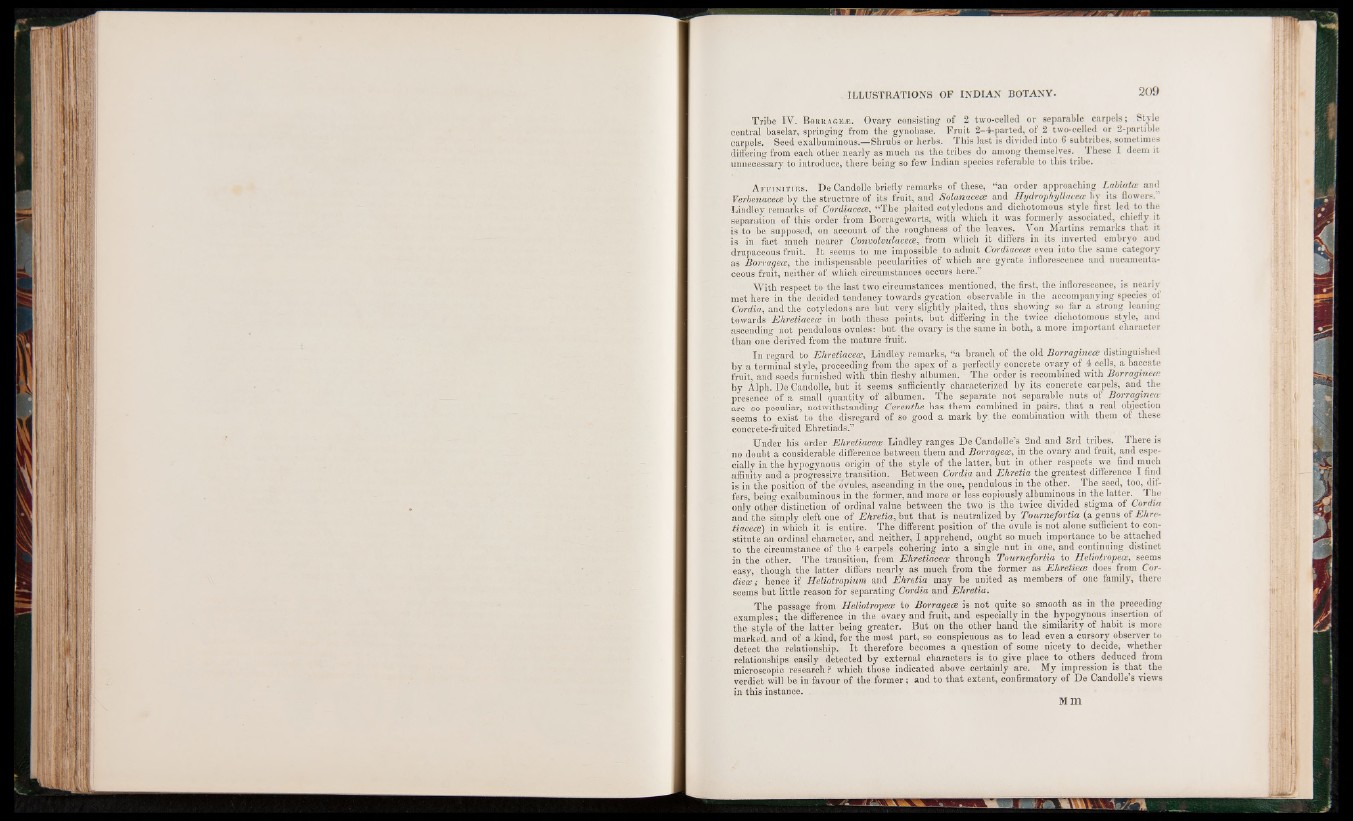
ILLUSTRATIONS OF INDIAN BOTANY.
Tribe IV. Boriiage.e. Ovary consisting of 2 two-celled or separable carpels; Style
central baselar, springing from the gynobase. Fruit 2-4-parted, of 2 two-celled or 2-partible
carpels. Seed exalbuminous.—Shrubs or herbs. This last is divided into 6 subtribes, sometimes
differing from each other nearly as much as the tribes do among themselves. ^ These I deem it
unnecessary to introduce, there being so few Indian species referable to this tribe.
A f f in i t i e s . De Candolle briefly remarks of these, “an order approaching Labiatce and
Verbenacece by the structure of its fruit, and Solanacece and Hydrophyllacece by its flowers.”
Lindley remarks of Cordiacece, “The plaited cotyledons and dichotomous style first led to the
separation of this order from Borrageworts, with which it was formerly associated, chiefly it
is to be supposed, on account of the roughness of the leaves. Von Martins remarks that it
is in fact much nearer Comiolvulacece, from which it differs in its inverted embryo and
drupaceous fruit. It seems to me impossible to admit Cordiacece even into the same category
as Borragece, the indispensable pecularities of which are gyrate inflorescence and nucamenta-
ceous fruit, neither of which circumstances occurs here.”
With respect to the last two circumstances mentioned, the first, the inflorescence, is nearly
met here in the decided tendency towards gyration observable in the accompanying species. of
Cordia, and the cotyledons are but very slightly plaited, thus showing so far a strong leaning
towards Ehretiacece in both these points, but differing in the twice dichotomous style, and
ascending hot pendulous ovules: but the ovary is the same in both, a more important character
than one.derived from the mature fruit.
In regard to Ehretiacece, Lindley remarks, “a branch of the old Borraginece distinguished
by a terminal style, proceeding from the apex of a perfectly concrete ovary of 4 cells, a baccate
fruit, and seeds furnished with thin fleshy albumen. The order is recombined with Borraginece
by Alph. De Candolle, but it seems sufficiently characterized by its concrete carpels, and the
presence of a small quantity of albumen. The separate not separable nuts of Borraginece
are so peculiar, notwithstanding Cerenthe has them combined in pairs, that a real objection
seems to exist to the disregard of so good a mark by. the combination with them of these
concrete-fruited Ehretiads.”
Under his order Ehretiacece Lindley ranges De Candolle’s 2nd and 3rd tribes. There is
no doubt a considerable difference between them and Borragece, in the ovary and fruit, and especially
in the hypogynous origin of the style of the latter, but in other, respects we find much
affinity and a progressive transition. Between Cordia and Ehretia the greatest difference I find
is in the position of the'ovules, ascending in the one, pendulous in the other. The seed, too, differs,
being exalbuminous in the former, and more or less copiously albuminous in the latter. The
only other distinction of ordinal value between the two is the twice divided stigma of Cordia
and the simply cleft one of Ehretia, but that is neutralized by Tournefortia (a genus of Ehretiacece)
in which it is entire. The different position of the ovule is not alone sufficient to constitute
an ordinal character, and neither, I apprehend, ought so much importance to be attached
to the circumstance of the 4 carpels cohering into a single nut in one, and continuing distinct
in the other. The transition, from Ehretiacece through Tournefortia to Heliotropece, seems
easy, though the latter differs nearly as much from the former as Ehretiece does from Cor-
diece; hence if Heliotropium and Ehretia may be united as members of one family, there
seems but little reason for separating Cordia and Ehretia.
The passage from Heliotropece to Borragece is not quite so smooth as in the preceding
examples; the difference in the ovary and fruit, and especially in the hypogynous insertion of
the style of the latter being greater. But on the other hand the similarity of habit is more
marked, and of a kind, for the most part, so conspicuous as to lead even a cursory observer to
detect the relationship. It therefore becomes a question of some nicety to decide, whether
relationships easily detected by external characters is to give place to others deduced from
microscopic research? which those indicated above certainly are. My impression is that the
verdict will be in favour of the former; and to that extent, confirmatory of De Candolle’s views
in this instance. .
M m